Chevrolet PRIZM 1999 Manual
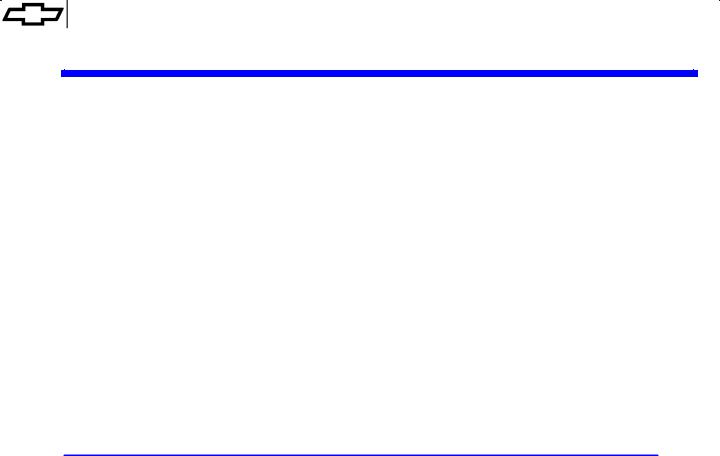
yellow blue
The 1999 Chevrolet Prizm Owner's Manual
1-1 Seats and Restraint Systems
This section tells you how to use your seats and safety belts properly. It also explains the air bag system.
2-1 Features and Controls
This section explains how to start and operate your vehicle.
3-1 Comfort Controls and Audio Systems
This section tells you how to adjust the ventilation and comfort controls and how to operate your audio system.
4-1 Your Driving and the Road
Here you'll find helpful information and tips about the road and how to drive under different conditions.
5-1 Problems on the Road
This section tells you what to do if you have a problem while driving, such as a flat tire or overheated engine, etc.
6-1 Service and Appearance Care
Here the manual tells you how to keep your vehicle running properly and looking good.
7-1 Maintenance Schedule
This section tells you when to perform vehicle maintenance and what fluids and lubricants to use.
8-1 Customer Assistance Information
This section tells you how to contact Chevrolet for assistance and how to get service and owner publications. It also gives you information on ªReporting Safety Defectsº on page 8-10.
9-1 Index
Here's an alphabetical listing of almost every subject in this manual. You can use it to quickly find something you want to read.
i
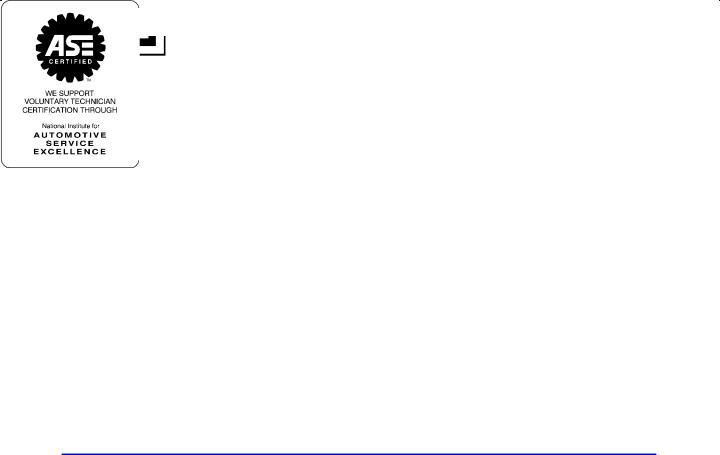
yellow blue
We support voluntary technician certification.
GENERAL MOTORS, GM, the GM Emblem, CHEVROLET, the CHEVROLET Emblem and the name PRIZM are registered trademarks of
General Motors Corporation.
This manual includes the latest information at the time it was printed. We reserve the right to make changes in the product after that time without further notice. For vehicles first sold in Canada, substitute the name ªGeneral Motors of Canada Limitedº for Chevrolet Motor Division whenever it appears in this manual.
Please keep this manual in your vehicle, so it will be there if you ever need it when you're on the road. If you sell the vehicle, please leave this manual in it so the new owner can use it.
Litho in U.S.A. |
ECopyright General Motors Corporation 1998 |
Part No. 22622221 A Second Edition |
All Rights Reserved |
ii

The Heritage of Chevrolet
Welcome to the largest automotive family in the
world -- the family of Chevrolet owners. You have selected a vehicle designed, engineered and crafted by teamwork, a
vehicle backed by a proud history of performance and value. Since the first ªClassic Sixº rolled off the line in 1912, more than 110 million Chevrolet cars and trucks have
yellow blue
The dynamic William C. ªBillyº
Durant shifted gears from making carriages to making cars, forming half the team that gave birth to Chevrolet.
worn the Chevrolet marque. That kind of reception from auto owners is unmatched by any other car manufacturer in the world.
Louis Chevrolet, the other half of the team, at the wheel of his experimental ªClassic Six,º which entered production in 1912.
That year 2999 vehicles were produced.
iii
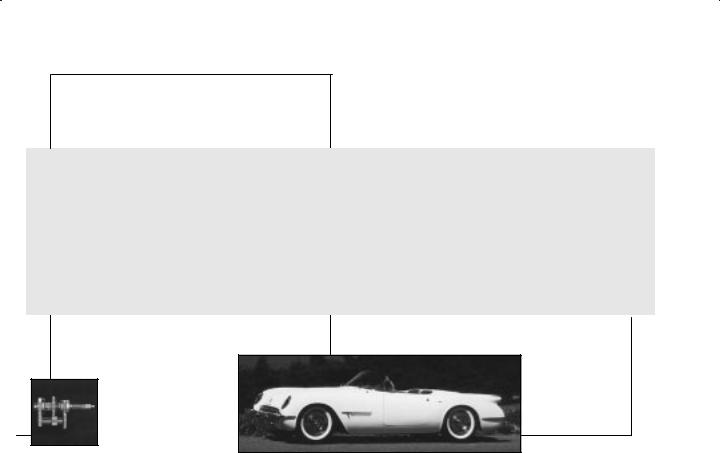
yellow blue
The Chevrolet blend of value and performance has become an American tradition -- whether bred for
the racetrack like the legendary Corvette and Camaro, or
In 1932 Chevrolet introduced the Synchro-Mesh transmission and offered a host of accessories -- including such niceties as a clock!
iv
created for the pleasure of the open road.
Every decade, Chevrolet has reinforced its heritage
of affordable performance with quality and value crafted
into each vehicle. It's not surprising that for 80 years ªGenuine Chevroletº has been America's automobile.
We're proud to continue that heritage in your Chevrolet,
The legacy of America's favorite sportscar began in 1953, when 319 hand-assembled white Corvettes
launched the first use of a fiberglass body in a production car.
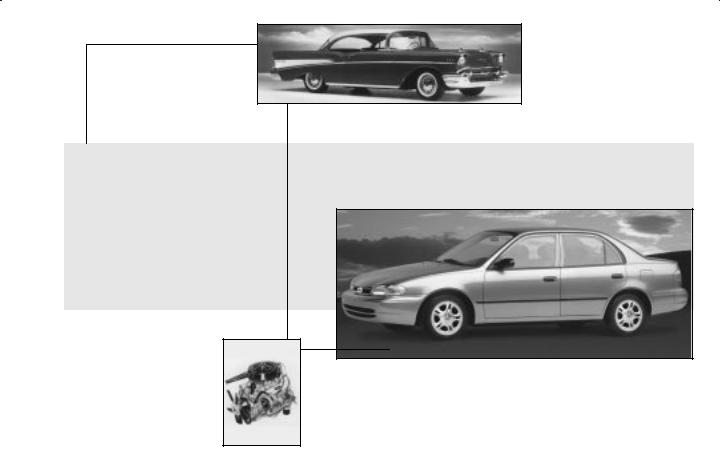
yellow blue
The 1957 Chevy started a romance with the American public -- and was powered by an available fuel-injected V8.
and we are pledged to
make ownership of your
Chevrolet an enjoyable
and rewarding experience.
60's automotive excitement included Chevrolet landmarks like the Corvette Sting Ray, the sporty Camaro, and powerplants like the legendary 327 V8.
Your new Chevrolet continues a tradition of quality and value.
v
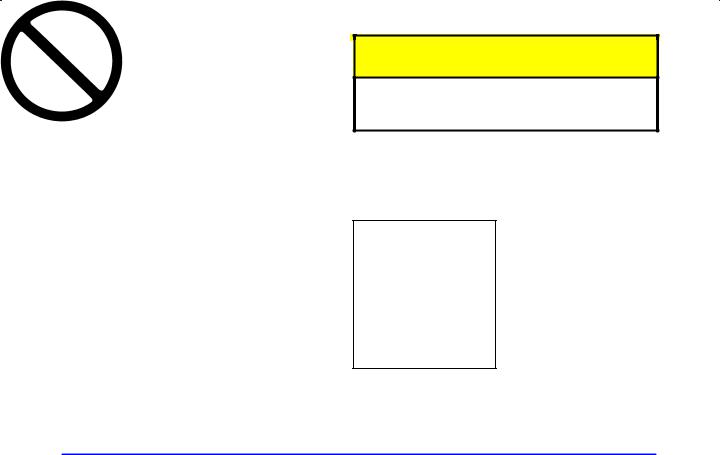
How to Use this Manual
Many people read their owner's manual from beginning to end when they first receive their new vehicle. If you do this, it will help you learn about the features and controls for your vehicle. In this manual, you'll find that pictures and words work together to explain
things quickly.
Index
A good place to look for what you need is the Index in back of the manual. It's an alphabetical list of what's in the manual, and the page number where you'll find it.
Safety Warnings and Symbols
You will find a number of safety cautions in this book. We use a box and the word CAUTION to tell you about things that could hurt you if you were to ignore the warning.
yellow blue
 CAUTION:
CAUTION:
These mean there is something that could hurt you or other people.
In the caution area, we tell you what the hazard is. Then we tell you what to do to help avoid or reduce the hazard. Please read these cautions. If you don't, you or others could be hurt.
You will also find a circle with a slash through it in this book. This safety symbol means ªDon't,º ªDon't do thisº or ªDon't let this happen.º
vi
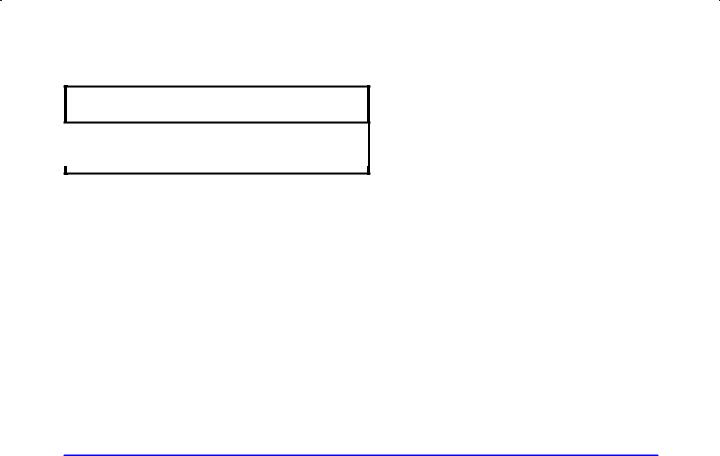
Vehicle Damage Warnings
Also, in this book you will find these notices:
NOTICE:
These mean there is something that could damage your vehicle.
yellow blue
In the notice area, we tell you about something that can damage your vehicle. Many times, this damage would not be covered by your warranty, and it could be costly. But the notice will tell you what to do to help avoid the damage.
When you read other manuals, you might see CAUTION and NOTICE warnings in different colors or in different words.
You'll also see warning labels on your vehicle. They use the same words, CAUTION or NOTICE.
vii
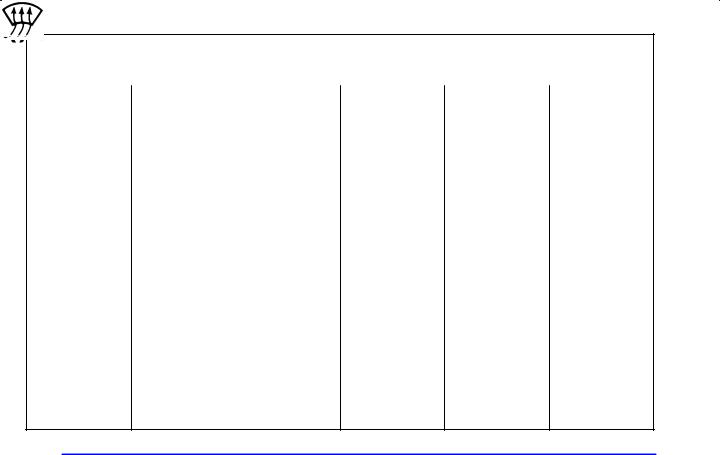
yellow blue
Vehicle Symbols
These are some of the symbols you may find on your vehicle.
For example, these symbols are used on an original battery:
CAUTION
POSSIBLE
INJURY
PROTECT
EYES BY
SHIELDING
CAUSTIC
BATTERY
ACID COULD
CAUSE
BURNS
AVOID
SPARKS OR
FLAMES
SPARK OR
FLAME
COULD
EXPLODE
BATTERY
These symbols |
These symbols |
|
are important |
have to do with |
|
for you and |
your lamps: |
|
your passengers |
|
|
whenever your |
MASTER |
|
vehicle is |
||
LIGHTING |
||
driven: |
||
SWITCH |
||
|
||
DOOR LOCK |
TURN |
|
UNLOCK |
SIGNALS |
|
|
PARKING |
|
FASTEN |
LAMPS |
|
|
||
SEAT |
|
|
BELTS |
HAZARD |
|
|
WARNING |
|
|
FLASHER |
|
POWER |
DAYTIME |
|
WINDOW |
RUNNING |
|
|
LAMPS |
|
AIR BAG |
FOG LAMPS |
|
|
|
These symbols are on some of your controls:
WINDSHIELD
WIPER
WINDSHIELD
WASHER
WINDSHIELD
DEFROSTER
REAR
WINDOW
DEFOGGER
VENTILATING FAN
These symbols are used on warning and indicator lights:
ENGINE
COOLANT
TEMP
BATTERY
CHARGING
SYSTEM
BRAKE
COOLANT
ENGINE OIL
PRESSURE
ANTI-LOCK
BRAKES
Here are some other symbols you may see:
FUSE
LIGHTER
HORN
SPEAKER
FUEL
viii
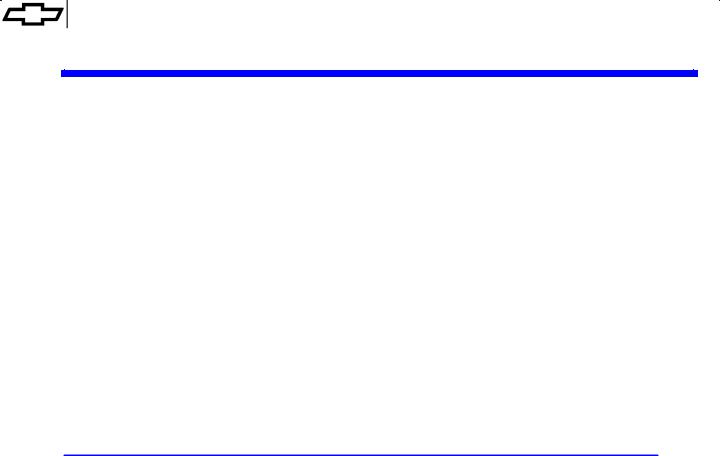
yellow blue
Section 1 Seats and Restraint Systems
Here you'll find information about the seats in your vehicle and how to use your safety belts properly. You can also learn about some things you should not do with air bags and safety belts.
1-2 |
Seats and Seat Controls |
|
1-30 |
Rear Seat Passengers |
|
||||
1-7 |
Safety Belts: They're for Everyone |
|
1-33 |
Children |
1-12 |
Here Are Questions Many People Ask About |
|
1-35 |
Built-in Child Restraint (Option) |
|
Safety Belts -- and the Answers |
|
1-47 |
Child Restraints |
1-13 |
How to Wear Safety Belts Properly |
|
1-57 |
Larger Children |
1-13 |
Driver Position |
|
1-60 |
Safety Belt Extender |
1-20 |
Safety Belt Use During Pregnancy |
|
1-60 |
Checking Your Restraint Systems |
1-21 |
Right Front Passenger Position |
|
1-61 |
Replacing Restraint System Parts After |
1-21 |
Air Bag Systems |
|
|
a Crash |
1-30 |
Safety Belt Pretensioners |
|
|
|
|
|
|
|
|
1-1
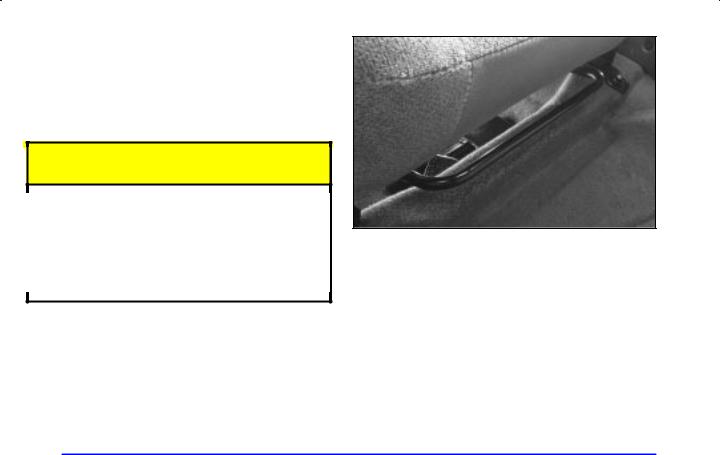
Seats and Seat Controls
This part tells you about the seats -- how to adjust them, and also about reclining front seatbacks, head restraints and rear folding seatbacks.
Manual Front Seats
 CAUTION:
CAUTION:
You can lose control of the vehicle if you try to adjust a manual driver's seat while the vehicle is moving. The sudden movement could startle and confuse you, or make you push a pedal when you don't want to. Adjust the driver's seat only when the vehicle is not moving.
yellow blue
Lift the lever under the front seat to unlock it. Slide the seat to where you want it. Release the lever and try to move the seat with your body, to make sure the seat is locked into place.
Don't put anything under the front seats. Items under the seats could keep the seats from locking into place properly.
1-2
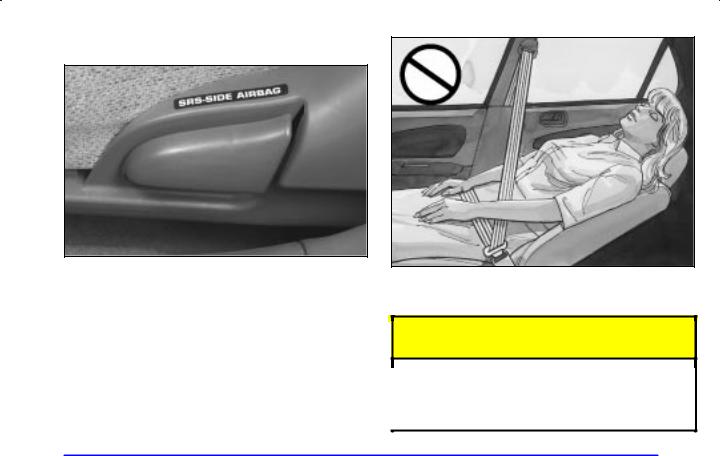
Reclining Front Seatbacks
To adjust the seatback, lift the lever on the outer side of the seat. Release the lever to lock the seatback where you want it. Push on the seat to make sure it's locked into position. Pull up on the lever, and the seat will go to its original upright position.
yellow blue
But don't have a seatback reclined if your vehicle is moving.
 CAUTION:
CAUTION:
Sitting in a reclined position when your vehicle is in motion can be dangerous. Even if you buckle
CAUTION: (Continued)
1-3
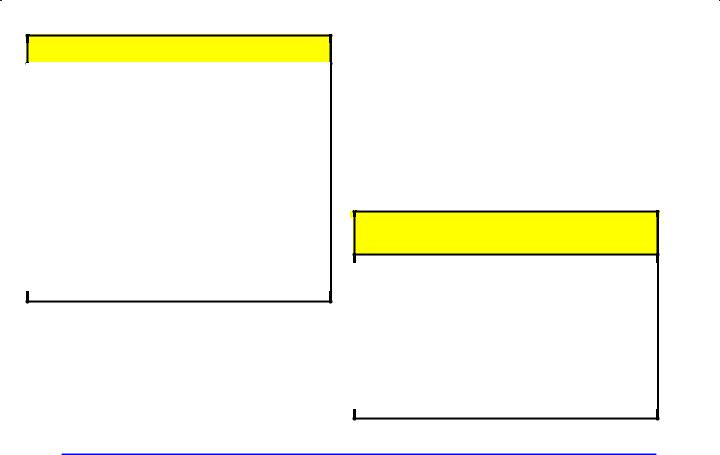
CAUTION: (Continued)
up, your safety belts can't do their job when you're reclined like this.
The shoulder belt can't do its job because it won't be against your body. Instead, it will be in front of you. In a crash you could go into it, receiving neck or other injuries.
The lap belt can't do its job either. In a crash the belt could go up over your abdomen. The belt forces would be there, not at your pelvic bones. This could cause serious internal injuries.
For proper protection when the vehicle is in motion, have the seatback upright. Then sit well back in the seat and wear your safety belt properly.
yellow blue
Head Restraints
Slide the head restraint up or down so that the top of the restraint is closest to the top of your ears. This position reduces the chance of a neck injury in a crash.
Pull up to raise the restraint. To lower it, push the release button and push down.
Make sure the head restraint is locked in place after you adjust it.
Rear Seats
 CAUTION:
CAUTION:
If a head restraint is not installed on the seatback or stored in the vehicle properly, it could be thrown about the vehicle in a crash or sudden maneuver. People in the vehicle could be injured. Remove the head restraints only when you need to fold the seat, and be sure that the head restraints are stored securely in the trunk. When the seat is returned to the passenger position, be sure the head restraints are installed properly.
1-4

Rear Head Restraint Removal
To remove the rear head restraints:
1.Press the release button located under the left side of the head restraint.
2.Lift the head restraint upward.
3.Secure the head restraints in the trunk using the tie-down straps located on each side of the trunk floor.
To reinstall the rear head restraints:
1.Remove the head restraints from the trunk.
2.Press and hold the release button on the seat back while inserting the head restraint.
3.Push the head restraint down. After releasing the button, pull on the head restraint to make sure it is secure.
yellow blue
Rear Folding Seatback (If Equipped)
You can fold either side of the seatback down in your vehicle for more cargo space. On vehicles with a built-in child restraint system, only the driver's side rear passenger seatback can be folded down. Make sure the front seat isn't reclined. If it is, the rear seatback won't fold down all the way.
 CAUTION:
CAUTION:
A safety belt that is twisted or not properly attached won't provide the protection needed in a crash. A person wearing a twisted or not properly attached belt could be seriously injured. After raising the rear seatback, always check to be sure that the safety belt is not twisted and is properly attached.
1-5
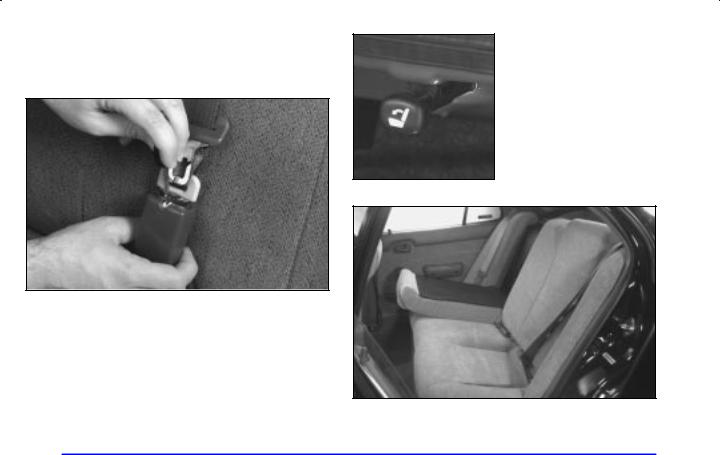
To fold either seatback down:
1.Remove the head restraints. See ªRear Head Restraint Removalº earlier in this section.
2.Remove the rear center lap-shoulder belt latch by using a key to press the release button.
yellow blue
3.Pull the release on the driver's side in the trunk. (Repeat the procedure for the other
side if you do not have a built-in child restraint.)
4. Fold the seatback down.
1-6

To raise the seatback:
1.Pull the seatback up and push it back to lock it into place. Make sure the safety belts are not twisted or caught in the seatback.
2.Push and pull the top of the seatback to be sure it is locked into position.
3. Reconnect the center seat belt.
yellow blue
Safety Belts: They're for Everyone
This part of the manual tells you how to use safety belts properly. It also tells you some things you should not do with safety belts.
And it explains the air bag system.
 CAUTION:
CAUTION:
Don't let anyone ride where he or she can't wear a safety belt properly. If you are in a crash and you're not wearing a safety belt, your injuries can be much worse. You can hit things inside the vehicle or be ejected from it. You can be seriously injured or killed. In the same crash, you might not be if you are buckled up. Always fasten your safety belt, and check that your passengers' belts are fastened properly too.
1-7
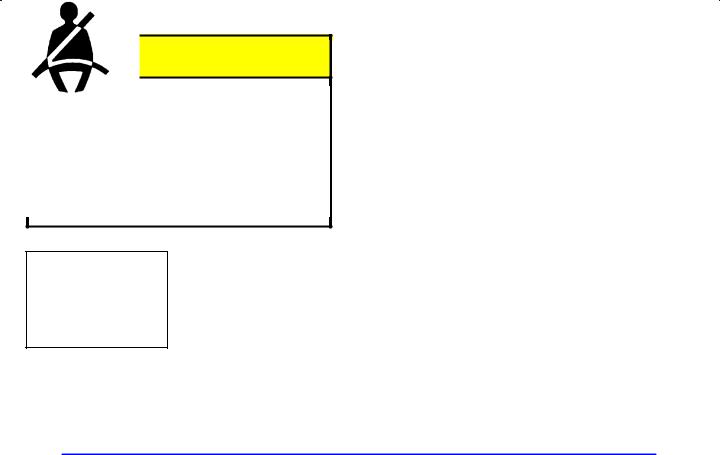
 CAUTION:
CAUTION:
It is extremely dangerous to ride in a cargo area, inside or outside of a vehicle. In a collision, people riding in these areas are more likely to be seriously injured or killed. Do not allow people to ride in any area of your vehicle that is not equipped with seats and safety belts. Be sure everyone in your vehicle is in a seat and using a safety belt properly.
Your vehicle has a light that comes on as a reminder to buckle up. (See ªSafety Belt Reminder Lightº in
the Index.)
yellow blue
In most states and Canadian provinces, the law says to wear safety belts. Here's why: They work.
You never know if you'll be in a crash. If you do have a crash, you don't know if it will be a bad one.
A few crashes are mild, and some crashes can be so serious that even buckled up a person wouldn't survive. But most crashes are in between. In many of them, people who buckle up can survive and sometimes walk away. Without belts they could have been badly hurt
or killed.
After more than 30 years of safety belts in vehicles, the facts are clear. In most crashes buckling up does matter ... a lot!
1-8
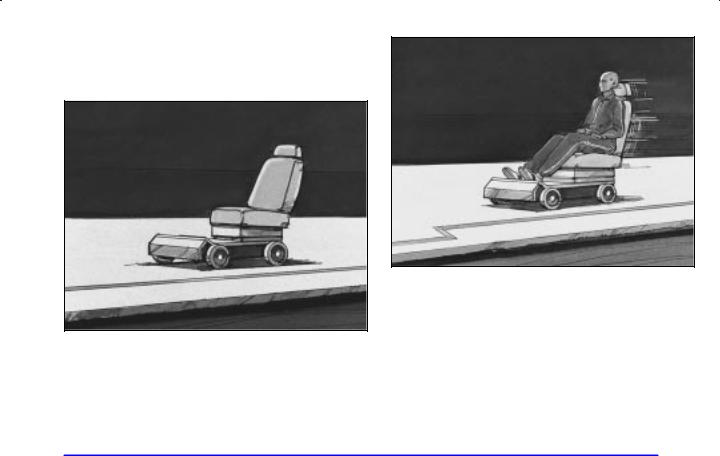
yellow blue
Why Safety Belts Work
When you ride in or on anything, you go as fast as it goes.
Put someone on it.
Take the simplest vehicle. Suppose it's just a seat on wheels.
1-9
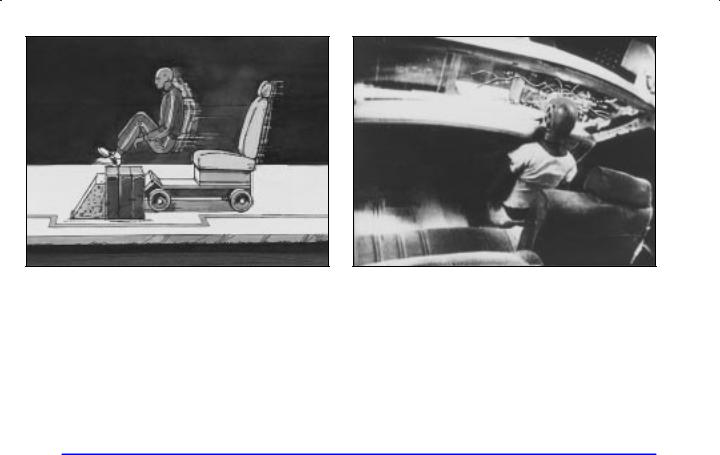
yellow blue
Get it up to speed. Then stop the vehicle. The rider doesn't stop.
The person keeps going until stopped by something.
In a real vehicle, it could be the windshield ...
1-10
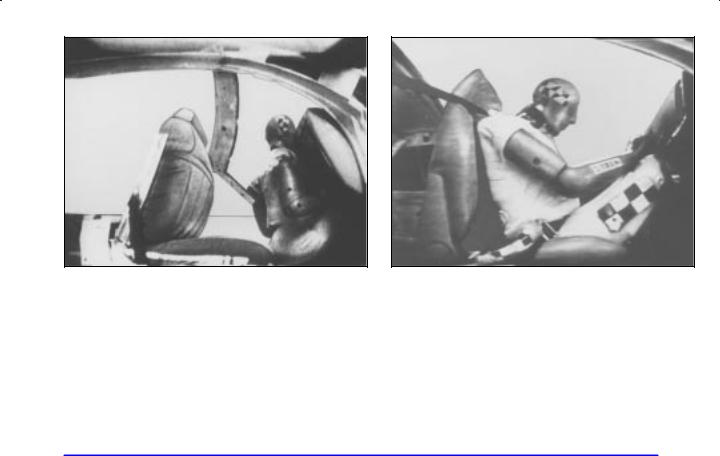
yellow blue
or the instrument panel ... |
or the safety belts! |
|
With safety belts, you slow down as the vehicle does. |
|
You get more time to stop. You stop over more distance, |
|
and your strongest bones take the forces. That's why |
|
safety belts make such good sense. |
1-11

Here Are Questions Many People Ask About Safety Belts -- and the Answers
Q: Won't I be trapped in the vehicle after an accident if I'm wearing a safety belt?
A: You could be -- whether you're wearing a safety belt or not. But you can unbuckle a safety belt, even if you're upside down. And your chance of being conscious during and after an accident, so you can unbuckle and get out, is much greater if you are belted.
Q: If my vehicle has air bags, why should I have to wear safety belts?
A: Air bags are in many vehicles today and will be in most of them in the future. But they are supplemental systems only; so they work with safety belts -- not instead of them. Every air bag system ever offered for sale has required the use of safety belts. Even if you're in a vehicle that has air bags, you still have to buckle up to get the most protection. That's true not only in frontal collisions, but especially in side and other collisions.
yellow blue
Q: If I'm a good driver, and I never drive far from home, why should I wear safety belts?
A: You may be an excellent driver, but if you're in an accident -- even one that isn't your fault -- you and your passengers can be hurt. Being a good driver doesn't protect you from things beyond your control, such as bad drivers.
Most accidents occur within 25 miles (40 km) of home. And the greatest number of serious injuries and deaths occur at speeds of less than 40 mph (65 km/h).
Safety belts are for everyone.
1-12
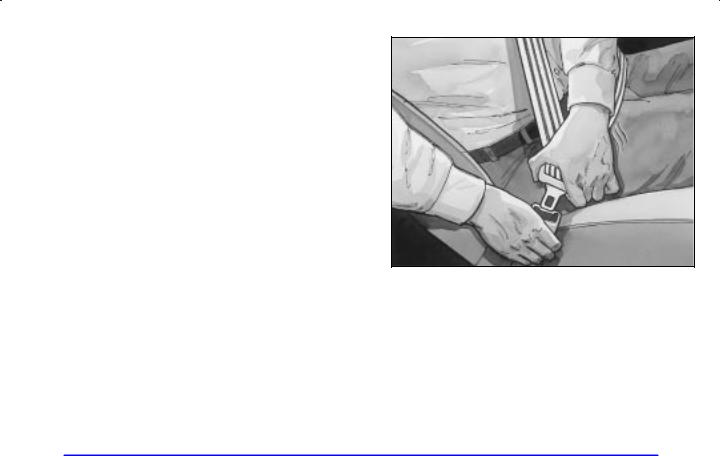
How to Wear Safety Belts Properly
Adults
This part is only for people of adult size.
Be aware that there are special things to know about safety belts and children. And there are different rules for smaller children and babies. If a child will be riding in your vehicle, see the part of this manual called ªChildren.º Follow those rules for
everyone's protection.
First, you'll want to know which restraint systems your vehicle has.
We'll start with the driver position.
Driver Position
This part describes the driver's restraint system.
Lap-Shoulder Belt
The driver has a lap-shoulder belt. Here's how to wear it properly.
1.Close and lock the door.
2.Adjust the seat (to see how, see ªSeatsº in the Index) so you can sit up straight.
yellow blue
3.Pick up the latch plate and pull the belt across you. Don't let it get twisted.
The shoulder belt may lock if you pull the belt across you very quickly. If this happens, let the belt go back slightly to unlock it. Then pull the belt across you more slowly.
1-13
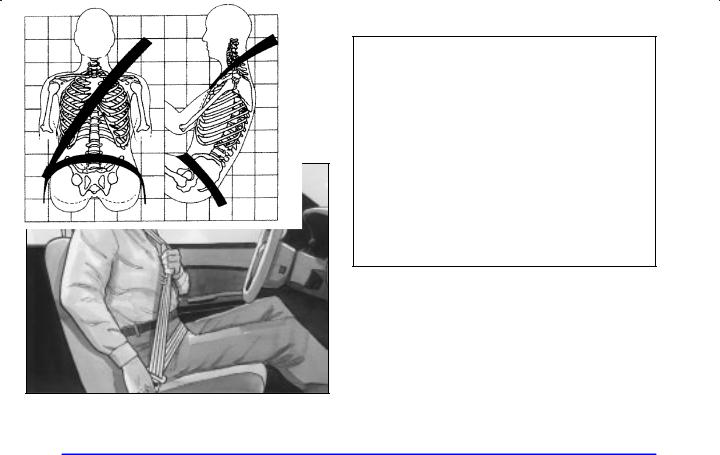
4.Push the latch plate into the buckle until it clicks.
Pull up on the latch plate to make sure it is secure. If the belt isn't long enough, see ªSafety Belt Extenderº at the end of this section.
Make sure the release button on the buckle is positioned so you would be able to unbuckle the safety belt quickly if you ever had to.
5.To make the lap part tight, pull down on the buckle end of the belt as you pull up on the shoulder belt.
yellow blue
The lap part of the belt should be worn low and snug on the hips, just touching the thighs. In a crash, this applies force to the strong pelvic bones. And you'd be less likely to slide under the lap belt. If you slid under it, the belt would apply force at your abdomen. This could cause serious or even fatal injuries. The shoulder belt should go over the shoulder and across the chest. These parts of the body are best able to take belt restraining forces.
The safety belt locks if there's a sudden stop or crash, or if you pull the belt very quickly out of the retractor.
1-14
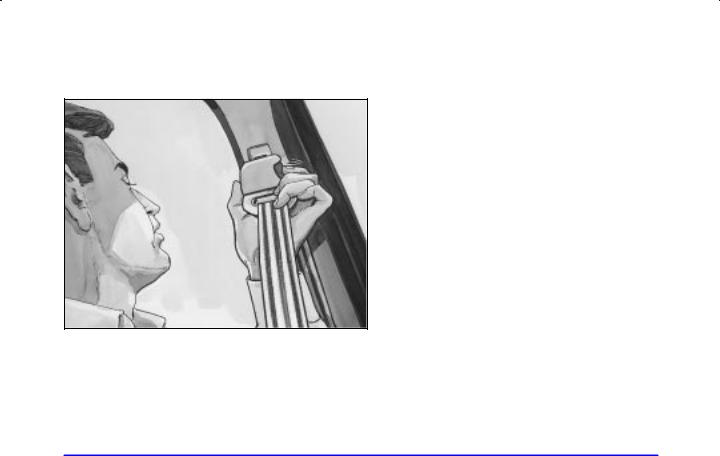
Shoulder Belt Height Adjuster
Before you begin to drive, move the shoulder belt adjuster to the height that is right for you.
yellow blue
To move it down, squeeze the release button and move the height adjuster to the desired position. You can move the adjuster up just by pushing up on the shoulder belt guide. After you move the adjuster to where you want it, try to move it down without squeezing the release button to make sure it has locked into position.
Adjust the height so that the shoulder portion of the belt is centered on your shoulder. The belt should be away from your face and neck, but not falling off your shoulder.
1-15
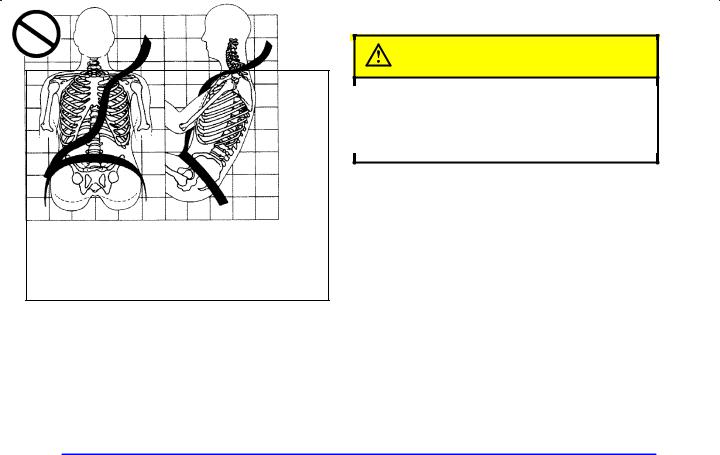
yellow blue
Q: What's wrong with this?
CAUTION:
You can be seriously hurt if your shoulder belt is too loose. In a crash, you would move forward too much, which could increase injury. The shoulder belt should fit against your body.
A: The shoulder belt is too loose. It won't give nearly as much protection this way.
1-16
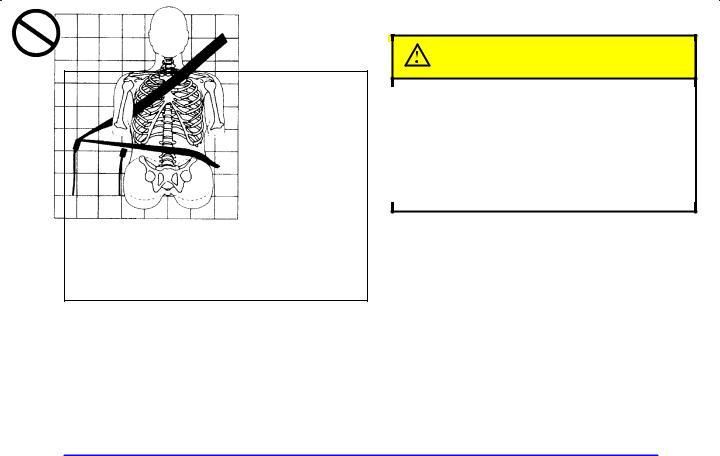
yellow blue
Q: What's wrong with this?
CAUTION:
You can be seriously injured if your belt is buckled in the wrong place like this. In a crash, the belt would go up over your abdomen. The belt forces would be there, not at the pelvic bones. This could cause serious internal injuries. Always buckle your belt into the buckle
nearest you.
A: The belt is buckled in the wrong place.
1-17
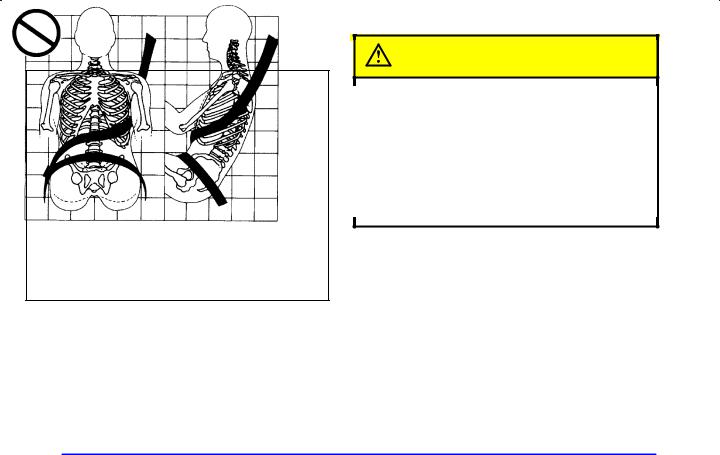
yellow blue
Q: What's wrong with this?
CAUTION:
You can be seriously injured if you wear the shoulder belt under your arm. In a crash, your body would move too far forward, which would increase the chance of head and neck injury. Also, the belt would apply too much force to the ribs, which aren't as strong as shoulder bones. You could also severely injure internal organs like your liver or spleen.
A: The shoulder belt is worn under the arm. It should be worn over the shoulder at all times.
1-18

yellow blue
Q: What's wrong with this?
CAUTION:
You can be seriously injured by a twisted belt. In a crash, you wouldn't have the full width of the belt to spread impact forces. If a belt is twisted, make it straight so it can work properly, or ask your dealer to fix it.
A: The belt is twisted across the body.
1-19
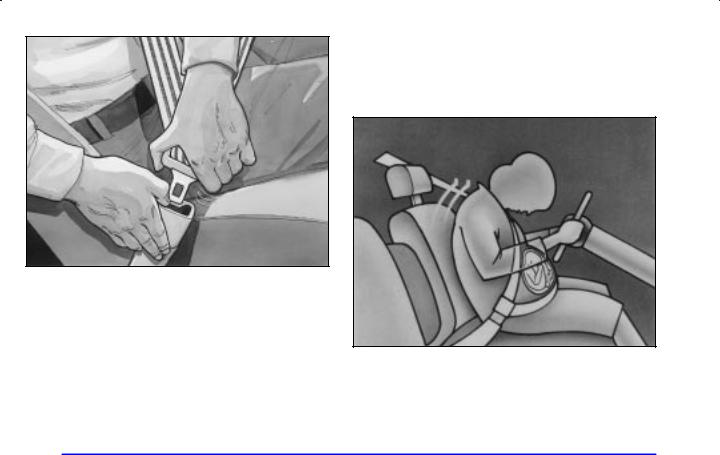
To unlatch the belt, just push the button on the buckle. The belt should go back out of the way.
Before you close the door, be sure the belt is out of the way. If you slam the door on it, you can damage both the belt and your vehicle.
yellow blue
Safety Belt Use During Pregnancy
Safety belts work for everyone, including pregnant women. Like all occupants, they are more likely to be seriously injured if they don't wear safety belts.
A pregnant woman should wear a lap-shoulder belt, and the lap portion should be worn as low as possible, below the rounding, throughout the pregnancy.
1-20
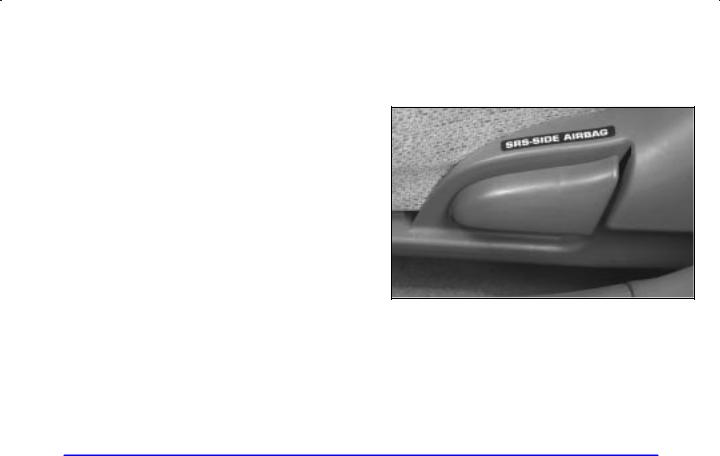
The best way to protect the fetus is to protect the mother. When a safety belt is worn properly, it's more likely that the fetus won't be hurt in a crash. For pregnant women, as for anyone, the key to making safety belts effective is wearing them properly.
Right Front Passenger Position
To learn how to wear the right front passenger's safety belt properly, see ªDriver Positionº earlier in this section.
The right front passenger's safety belt works the same way as the driver's safety belt -- except for one thing. If you ever pull the shoulder portion of the belt out all the way, you will engage the child restraint locking feature. If this happens, just let the belt go back all the way and start again.
Air Bag Systems
This part explains the frontal and side impact air bag systems.
Your vehicle has air bags -- a ªNext Generationº frontal air bag for the driver and another ªNext Generationº frontal air bag for the right front passenger. Your vehicle may also have side impact air bags -- a side impact air bag for the driver and another side impact air bag for the right front passenger.
yellow blue
If your vehicle has side impact air bags, it will say SRS - SIDE AIRBAG on a label on the side of the driver's and right front passenger's seat closest to the door.
Next Generation frontal air bags are designed to help reduce the risk of injury from the force of an inflating frontal air bag. But even these air bags must inflate very quickly if they are to do their job and comply with federal regulations.
1-21
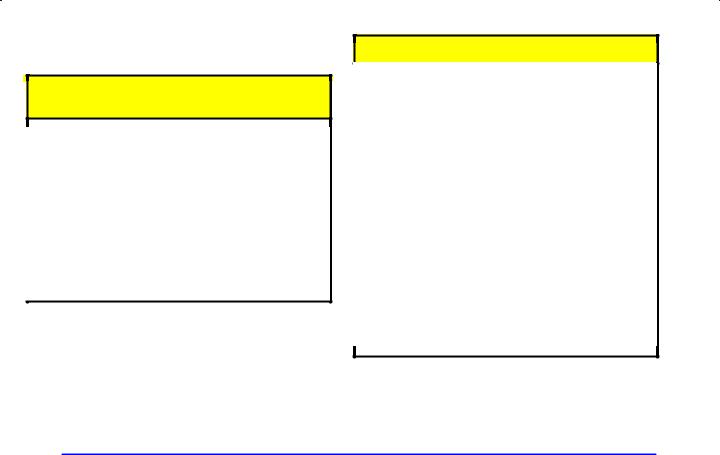
Here are the most important things to know about the air bag systems:
 CAUTION:
CAUTION:
You can be severely injured or killed in a crash if you aren't wearing your safety belt -- even if you have air bags. Wearing your safety belt during a crash helps reduce your chance of hitting things inside the vehicle or being ejected from it. Air bags are ªsupplemental restraintsº to the safety belts. All air bags -- even Next Generation air bags -- are designed to work with safety belts but don't replace them.
CAUTION: (Continued)
yellow blue
CAUTION: (Continued)
Next Generation frontal air bags for the driver and right front passenger are designed to work only in moderate to severe crashes where the front of your vehicle hits something. They aren't designed to inflate at all in rollover, rear, side or low-speed frontal crashes. And, for unrestrained occupants, Next Generation frontal air bags may provide less protection in frontal crashes than more forceful air bags have provided in the past. The side impact air bags for the driver and right front passenger are designed to inflate only in moderate to severe crashes where something hits the side of your vehicle. They aren't designed to inflate in frontal, in rollover or in rear crashes. Everyone in your vehicle should wear a safety belt properly -- whether or not there's an air bag for that person.
1-22
